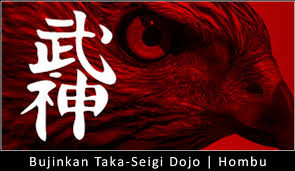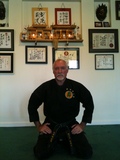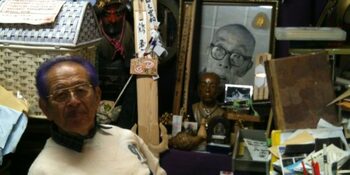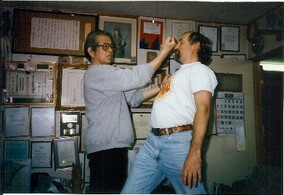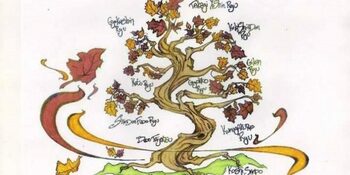
Will Your Training Save you (part 2)
10.12.18
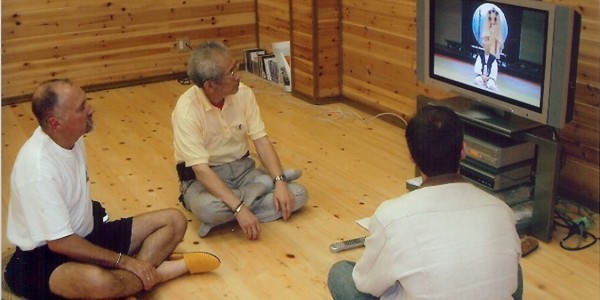
Make sure you read Part 1 first!
SO, what IS the best way to train? How do we know our training will save us in our darkest hour?
The short answer is: There is no magic way to train to guarantee success in all situations.
You have heard that there are no guarantees in life, right? Well, I hate to say this, but there are no guarantees in training either. We can only train to the best and fullest of our ability, be aware of our surroundings, be open to options (not set or rigid in thought), stay in the best of health and experience as much of life as we possibly can. It also helps to surround yourself with good people. Doing all these things reduces the odds that you will encounter violence and increases your odds of surviving violence should it come looking for you. Of course you can do everything right and a safe could still fall out of a 10-story building and die. What follows is what I believe about proper training.
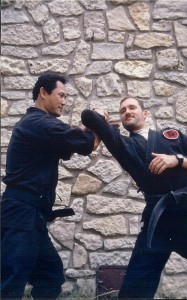
Nagato-sensei teaching me Onikudaki
I believe you must first build a solid base or foundation to your martial arts capability. For the Bujinkan; Kihon Happo, Go Gyo and Tenchijin Raku no Maki are our foundation. These form the cornerstone of our art and the base upon which we build our tower of skill upon. Law enforcement and the military call this basic training or boot camp. Thinking about firearms specifically, this would be basic marksmanship training.
If we only build the base we will likely never get to a point in our training, no matter how many years we practice, where we can act spontaneously. We will not know how to deal with a situation that is out of context with our training regime. Conversely, if we go straight to Soke’s way of movement without taking the time to set up a strong foundation we will be building ourselves a house of cards. We might look pretty, but we would have no substance whatsoever. Would you bet your life on poorly constructed abilities? I caution all of my students and new instructors not to rush teaching the fundamentals. Work them for as long as it takes to build a solid base of understanding of our art. Don’t be in a hurry to skip past the “boring” fundamentals and onto the “cool” Henka stuff.
Think of the two examples above in a firearms training context. Only studying the basics— law enforcement officers who only train in marksmanship will not be able to react appropriately to a shooting incident that is outside the confines of their range training. In fact, that basic training could get them killed in a real situation. There were numerous case studies of this exact phenomenon documented in the 70s and 80s, where police officers were observed in active shootouts drawing their service weapon, firing two shots, holstering a safe weapon, drawing their weapon again and repeating this process over and over. Incredibly, some were observed to take the time to “police” up their own brass or holster empty magazines back in their magazine pouches and sapping them shut. In the middle of a firefight!
Crazy right? Think it couldn’t happen to you? This was not just 1 or 2 raw recruits or sub-par officers, this happened to all types of officers at all levels, even seasoned and highly decorated ones! The reason was traced back to the way our officers were trained back then. This was how they always fired their weapons during training. There was no realistic or scenario based shooting training for the regular officer back then. That was reserved for SWAT type units and some State Troopers back then. Range etiquette, safety and marksmanship was considered more important than teaching the nation’s police force how to survive contact with an armed opponent. It happened often enough that the law enforcement community writ large changed their training system to emphasize contact shooting or simulated situation shooting after officers completed their annual marksmanship qualifications.
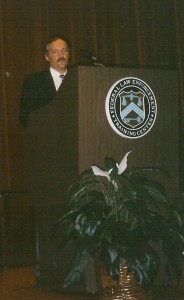
My speech as class president at FLETEC graduation
Learning only variations and advance tactics (Henka)— think what would happen if police officers didn’t bother with learning how to shoot safely and accurately first. What if all they were taught was scenario shooting? I can’t imagine how many accidental discharges and incidental shootings we would have nationwide. Talk about losing the confidence of the public! When I went through the Federal Agent Criminal Investigator Training Program for Federal Agents at the Federal Law Enforcement Training Center (FLETC) in beautiful Brunswick, Georgia, one of my classmates shot himself in the butt because he merely went through the motions when clearing a role-playing assailant’s live weapon during a warrant serving exercise. He either didn’t fully understand the basics of gun handling or he did not practice them enough for this skill to come through for him in a stressful situation (i.e. always, always, always safe a weapon before putting it into your belt!). Up until this point our weapons training consisted of marksmanship at the range and tactical training on the mats with red guns. He failed to make the mental transition from red gun to live gun during our tactical exercise, under a high stress-changing environment, with a different weapon and out of context from his training. Fortunately for him, the weapon was loaded with simulated munitions and not live rounds.
Paraphrasing a quote from Don Roley’s blog related to the Nagamaki, “In Japanese there is a saying, Tsuke-yakiba. It refers to the tempering process when making a sword. Unless a Japanese sword is beaten well, no matter how shiny the outside is, the blade will be weak. The term has come into common usage to refer to someone with hastily acquired and shallowly understood knowledge.”
Studying the fundamentals too quickly and moving onto Henka and weapons before gaining a solid understanding can lead to weakness in your structure, weakness in your training, weakness in you as a martial artist. Getting to Don’s point, you only perpetuate this Tsuke-yakiba cycle if you learn something too quickly and then teach it to others. Don’s exact quote is provided in the endnotes below. His entire article is worth a read if you are an instructor in the Bujinkan.
Only once we have built a strong base should we move onto developing a rich context of our art by learning various henka of the basics, delving into specific Ryu and learning the characteristics of various weapons. Each Ryu and each weapon has its own Kihon Happo, usually embedded in the Shoden level of training. This should be studied thoroughly first before moving onto Henka or the advanced levels. We must consistently build upon our base to create a strong and deep foundation, full of context. Some of this can start while we are still learning the basics but it should not be the main thrust of our training until we are well grounded.
Base plus henka gives us a much better chance to deal with a situation outside the dojo for two reasons. First, we get more “looks” at different types of attacks, not just the standard long distance and slow attacks we are used to when studying the base. This helps us to recognize the attack as an attack and can jumpstart the Cerebrum brain to stay in control (not allowing the Reptile brain to take over) and start the Assess, Plan, Act process. Second, because we are learning variations, it can open our minds to perceive options for dealing with something that is not exactly the standard.
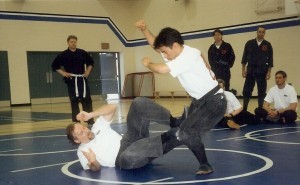
First ever Shinken Taijutsu training (ground defense)
Our Bujinkan henka training should include, but not be limited to more realistic punches, kicks, combos and grappling attacks. Sometimes it is appropriate to put on the gloves and spar a bit or go to ground and grapple. It should include realistic scenario training and use of different environments. It includes occasionally dressing in street clothes and street shoes in the dojo and training outside of the dojo in the grass or on the asphalt parking lot and in all elements. And it includes both historical weapons and modern weapons.
Most likely you will never have to face a crazed assailant welding a Nagamaki (one of the weapons for this new year), but the principles learned from training with a heavy sword mounted on a pole are of tremendous benefit to us as martial artists and also are applicable in a modern context: concepts of distance, timing, balance, yoyu (flexibility) and kukan (space) to name a few.
The reverse is also true. You must train with modern weapons, carried in the way that you would carry them and with their accompanying holsters, magazine pouches and ancillary equipment. Red guns in a holster are a great way to start. Then move up to an air soft gun in a holster. Wear protection and your air soft becomes a valid live training weapon that will teach you much about yourself and your technique. I like to use a loaded air soft to test my black belts’ abilities to move correctly during disarm drills. It’s a great motivator. [Note: A word of caution when handling real weapons, always train in a safe and controlled manner. Treat every weapon as if it were loaded. Only train with a live weapon under the supervision of an expert and always, always, always learn how to properly handle weapons in a safe manner so that you and everyone around you is safe.]
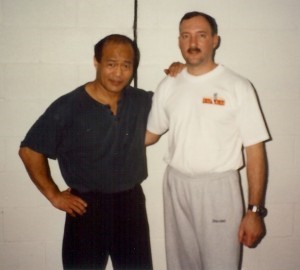
Training with the legendary Dan Inosanto
Finally, you should not just train in your own dojo or only with your teacher. Get out and see other schools, other teachers, and even other systems. Expand your Bujinkan experience with a diversity of training. Of course you should be loyal to your teacher and to your school for as long as they are worthy of your loyalty. I am not talking about being disrespectful; I’m talking about growing your training experience by observing how others teach and train. No one teacher has all the answers.
Soke quite often will tell students that if they want to learn about Shinken go see Phil. Soke has never been in combat, fired a gun in anger, or taken a life. It’s not something he has personally experienced, but he knows these are my experiences, things of which I am intimately familiar. I do the same thing. I recommend people train Dean Rostohar if they want to learn more about tactical shooting or combat knife fighting or with Mark Lithgow if you want to go really deep in the study of the sword. Last year I trained with Rory Miller at his Facing Violence seminar, hosted by Shihan Brent Earlewine at the Pittsburgh BTSD. It was a fascinating course and I have incorporated several of his concepts into my own Shinken program. I valued the experience so much that we plan to host Rory in Baltimore this year (21-22 March).
You see, I practice what I preach and encourage the same from my own dojo seniors.
So let me summarize the long answer with this: The more and different ways you sweat in training the less you bleed in combat.
Start with the basics. Develop a strong knowledge base and a fundamental understanding of whatever art/system you are training in. Don’t rush the basics, but when the time is right incorporate Henka into your training. Spar, learn various traditional and modern weapons, add in scenario training, train with others in the Bujinkan and experience others outside the Bujinkan too. Remember, no one person has all the answers. Be loyal, but seek out others who are better than you or have specific skills to train with. A great dojo leader will encourage you to do this, which is part of the “surrounding yourself with good people” aspect of successful training. Doing all this won’t guarantee a victory, but it will reduce your reaction time and heighten your ability to create options. You will move much more quickly from the “What the heck????” phase and into the “Okay, I got this” phase where the Cerebrum drives the Assess, Plan, Act process. Do all of this, but don’t forget to look up once in awhile too, just in case there really is a safe teetering on the ledge.
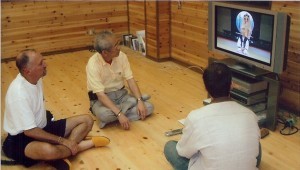
Sitting with Soke watching a Daikomyosai video and studying the key points.
Train: Practice, practice, and practice your basics. Never stop practicing basics. I am a 15th dan Dai Shihan and I still do the Kihon Happo and Go Gyo at the start of every class. Study. Read books by Soke and others. I know it’s old fashioned, but reading accesses another part of your Thinking brain for more comprehensive learning. Watch training videos. Watching training also accesses your Thinking brain on a level different from reading. Combine reading, watching videos and note taking will act as a “force multiplier” on your brain to learn.
Then practice, practice, practice under the supervision of your teacher and other seniors in the art. Be open to feedback, adjust, and then train more. Go to the source and train with Soke and the senior Shihan. Soke will inspire you, but not teach you any fundamentals. Why should he? He is the Grandmaster and lets face it, he has only so much time left to share what he knows, so he is training at the senior-most level. Seek out any of the other Japanese Shihan and refine your basics with them. That is what they are there for.
About 8 or 9 years ago, Soke told the Japanese Shihan to just teach basics for a while because the gaijin coming over to Japan had lost sight of what the basics were at that time. Train with others. If there is something specific you want to learn and it’s not being taught in your dojo or in another Bujinkan dojo then find another art
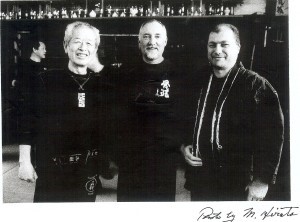
Soke, Phil, & Mark Lithgow at Honbu
and train in that on the side. We take pride in our art for being the best, but that doesn’t mean other schools have nothing to offer. Best example of this is Shihan Mark Lithgow. Not only is he a long-time and loyal Bujinkan Shihan, he is also a Shihan in Shinkage Ryu, one of the oldest and most respected sword schools in Japan. And he is highly ranked in the art of Kyudo (Japanese archery). I have deep respect for Mark for many reasons, but two that I will mention are: his lifelong dedication to the Bujinkan and his lifelong desire to be the best Japanese traditional martial artist that he can be. These two goals are not mutually exclusive. The way Mark leads his life makes his goals complimentary to each other. You can learn a LOT about being a proper Budoka from this man.
Hatsumi wrote in his book, Ninpo Wisdom for Life, “If someone keeps training without knowing the foundation and how it ‘blooms into a flower’ then it is certain he will have a ‘hollow mind and eyes.’ In Budo training you must first have a root [foundation] and then this will grow [develop] into a big tree [great ability]. In this way, a seed grows and a flower blooms.”
My motto is, “Strength Through Proper Training.” I take this seriously for my member website, where we have the most current and relevant training to be found anywhere in Budo Taijutsu and Shinken Taijutsu. Our featured instructors include: Soke, Nagato Sensei, Noguchi Sensei, myself and a number of well known foreign Shihan. Give us a test drive, we wont disappoint. Contact me directly if you are interested in the Shinken program. We have a number of certified Shinken instructors in the USA, Australia and Japan that you can train with. We have a training methodology that mirrors what I’ve talked about in this article. I am always looking for good people who want to learn this in depth and then go onto teach and help others.
I am interested in your views on this topic and welcome your comments and questions below.
In Gassho, Phil
References:
Facing Violence, Preparing for the Unexpected, by Rory Miller, YMAA Publication Center, ISBN-13: 978-1-59439-213-9.
S.P.E.A.R. System (Spontaneous, Protection, Enabling Accelerated, Response), by Tony Blauer. http://www.tonyblauer.com/4105/02_01_01_spearsystem.asp. Check the website for information about SPEAR and training opportunities. Also Shidoshi Michael Tucker, Birmingham, Alabama is a certified SPEAR instructor and can be contacted about training in SPEAR.
Federal Law Enforcement Training Centers (FLETC), https://www.fletc.gov/. See this website for more information on Federal sponsored law enforcement training programs.
BTSD Chudan Instructor Manual 4th edition, by Phillip Legare, current edition copyright 2011, $35ea, electronic and hard copies available. See the www.takaseigi.com website or the TakaSeigi FB page for more information about the Shinken Taijutsu training program.
Ninpo Wisdom for Life, by Masaaki Hatsumi, Mushashin Press, English text copyright 1998 by Joe Maurantonio, Editor, PO Box 146, Yonkers, NY 10710 USA. Page 18.
Ranting and Ravings, Why I wont be teaching Nagamaki, a Facebook blog by Don Roley, dated January 13, 2015. The full quote (without my edits) is provided here: “In Japanese there is a saying, Tsuke-yakiba. It refers to the tempering process. Unless a Japanese sword is beaten well, no matter how shiny the outside it, it is a crap blade. From there the term has come into common usage to refer to people with hastily acquired and shallowly understood knowledge. Picking something up quickly may allow you to make your living off of selling seminar tours, but it comes at the expense of real knowledge. And of course, by teaching stuff you really don’t know you fuck up everyone you teach.”
